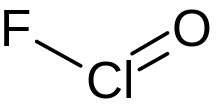 | |
| Names | |
|---|---|
| Other names Chlorine(III) fluoride oxide | |
| Identifiers | |
3D model (JSmol) | |
| ChEBI | |
| ChemSpider | |
PubChem CID | |
| |
| |
| Properties | |
| FClO | |
| Molar mass | 70.45 g·mol−1 |
Except where otherwise noted, data are given for materials in their standard state (at 25 °C [77 °F], 100 kPa). | |
Chlorosyl fluoride is an inorganic compound of chlorine, fluorine, and oxygen with the chemical formula F−Cl=O. [1] [2] [3]